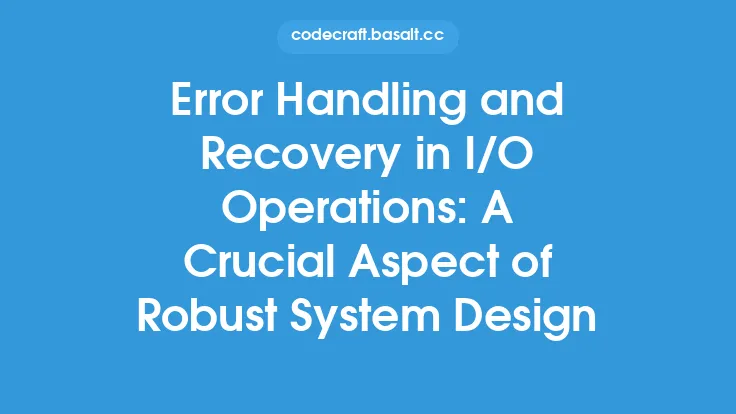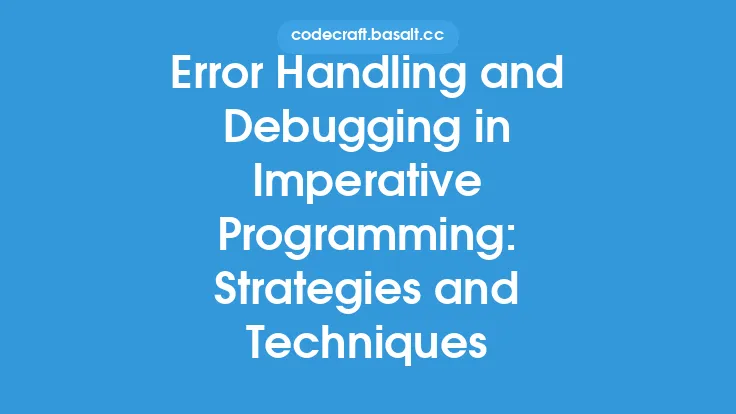System calls are the primary interface between user space and kernel space, allowing applications to request services from the operating system. However, system calls can fail due to various reasons, and it's essential to handle these errors properly to ensure the reliability and stability of the system. Error handling in system calls is a critical aspect of operating system design, and it requires careful consideration of various factors, including error types, error codes, and error handling mechanisms.
Introduction to Error Handling in System Calls
Error handling in system calls involves detecting and responding to errors that occur during the execution of system calls. Errors can occur due to various reasons, such as invalid input, resource unavailability, or internal kernel errors. The operating system provides error codes and error messages to help applications diagnose and handle errors. Effective error handling in system calls is crucial to prevent application crashes, data corruption, and security vulnerabilities.
Types of Errors in System Calls
There are several types of errors that can occur in system calls, including:
- Invalid input errors: These errors occur when the application provides invalid input to the system call, such as an invalid file descriptor or an invalid memory address.
- Resource unavailability errors: These errors occur when the system call cannot allocate the required resources, such as memory or file descriptors.
- Internal kernel errors: These errors occur due to internal kernel bugs or inconsistencies, such as a kernel panic or a page fault.
- Permission errors: These errors occur when the application does not have the required permissions to perform the system call, such as accessing a file or socket.
Error Codes and Error Messages
Error codes and error messages are essential components of error handling in system calls. Error codes are numerical values that indicate the type of error that occurred, while error messages provide a human-readable description of the error. The operating system provides a set of standard error codes and error messages that applications can use to diagnose and handle errors. For example, the POSIX standard defines a set of error codes, such as `EINVAL` for invalid input and `ENOMEM` for out-of-memory conditions.
Error Handling Mechanisms
There are several error handling mechanisms that applications can use to handle system call errors, including:
- Error code checking: Applications can check the error code returned by the system call to determine the type of error that occurred.
- Error message handling: Applications can handle error messages provided by the operating system to diagnose and handle errors.
- Retry mechanisms: Applications can implement retry mechanisms to retry the system call after a failure.
- Fallback mechanisms: Applications can implement fallback mechanisms to provide an alternative solution when a system call fails.
Best Practices for Error Handling in System Calls
To ensure effective error handling in system calls, applications should follow best practices, including:
- Checking error codes: Applications should always check the error code returned by the system call to determine the type of error that occurred.
- Handling error messages: Applications should handle error messages provided by the operating system to diagnose and handle errors.
- Implementing retry mechanisms: Applications should implement retry mechanisms to retry the system call after a failure.
- Providing fallback mechanisms: Applications should provide fallback mechanisms to provide an alternative solution when a system call fails.
- Logging errors: Applications should log errors to provide a record of errors and facilitate debugging.
Common Pitfalls in Error Handling
There are several common pitfalls that applications can encounter when handling system call errors, including:
- Ignoring error codes: Ignoring error codes can lead to unexpected behavior and crashes.
- Not handling error messages: Not handling error messages can make it difficult to diagnose and handle errors.
- Not implementing retry mechanisms: Not implementing retry mechanisms can lead to application failures and crashes.
- Not providing fallback mechanisms: Not providing fallback mechanisms can lead to application failures and crashes.
- Not logging errors: Not logging errors can make it difficult to diagnose and debug errors.
Conclusion
Error handling in system calls is a critical aspect of operating system design, and it requires careful consideration of various factors, including error types, error codes, and error handling mechanisms. By following best practices and avoiding common pitfalls, applications can ensure effective error handling in system calls and provide a reliable and stable user experience. Effective error handling in system calls is essential to prevent application crashes, data corruption, and security vulnerabilities, and it requires a deep understanding of system call error handling mechanisms and best practices.





